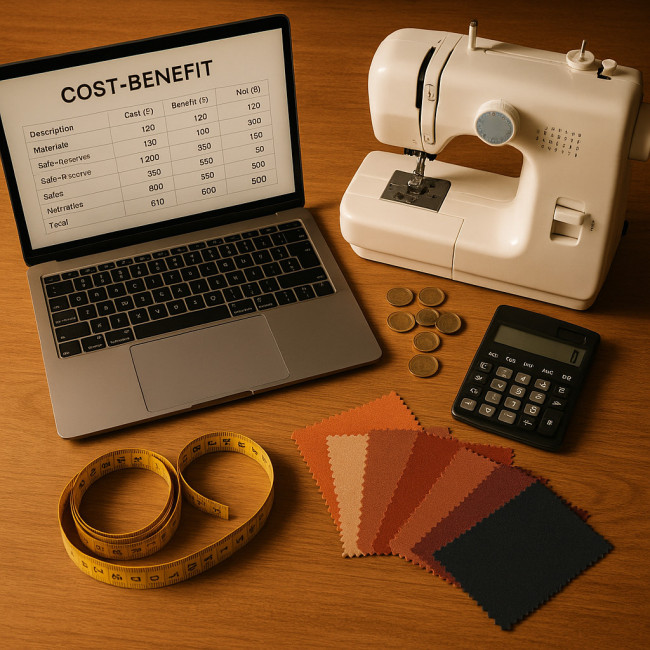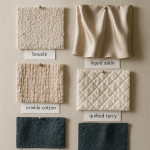Sewing machine upgrades: when to invest and which models fit small studios
Your sewing machine is the engine of your studio. Yet many designers hang on to an aging model that slows output, limits stitch options or guzzles maintenance time. This guide helps you decide when an upgrade makes financial sense and compares five compact machines that deliver professional results without swallowing your floor space—or your budget.
Why upgrading your sewing machine matters

Up-to-date mechanical parts translate directly into better stitch accuracy, reduced fabric waste and faster fulfilment of client briefs. In a small studio, every hour counts. Modern machines cut set-up time with automatic threaders, speed-control sliders and on-screen diagnostics. Over a full production season those incremental gains often outperform the upfront purchase price.
Hidden costs of “making do”
- Missed deadlines caused by frequent tension troubleshooting
- Extra fabric used for testing inconsistent stitches
- Repair bills and downtime when obsolete parts are hard to source
- Lost opportunities for advanced finishes (triple coverstitch, heirloom stitches) that premium clients now request
Five signals it is time to upgrade
- Stitch inconsistency: even after a full service, tension drifts across identical seams.
- Speed ceiling: you cannot surpass 700 stitches per minute (SPM) without vibration.
- Limited presser-foot clearance: bulky eco-textiles or multilayer quilts jam under the foot.
- No digital memory: repeating custom patterns requires manual dial resets.
- Noise complaints: home-studio neighbours comment on clatter that modern motors avoid.
Ticked two or more boxes? You are likely haemorrhaging profit. Upskilling on new-model features can open revenue from custom top-stitching, leather accessories or capsule runs without outsourcing.
Key criteria for small-studio machines
| Criterion | Why it matters | Target spec |
|---|---|---|
| Footprint | Leaves room for cutting tables & pressing stations | < 45 cm wide |
| Noise level | Neighbour-friendly evening work | < 70 dB |
| SPM range | Speeds up long straight seams | 800–1500 SPM |
| Built-in stitches | Eliminates specialty machines | > 20 core + 1 auto buttonhole |
| Motor torque | Handles denim, canvas, leather | Heavy-duty metal drive |
Model comparison: compact workhorses worth every centimetre
The five machines below balance power, versatility and size—ideal for designers moving from one-off samples to selective small-batch production.
| Model | Footprint (cm) | Max speed (SPM) | Stitches | Best for | Average street price (€) |
|---|---|---|---|---|---|
| Janome HD3000 | 40 × 18 | 860 | 18 | Denim & canvas outerwear | 650 |
| Brother CS7000X | 38 × 17 | 750 | 70 | Pattern-heavy light fabrics | 340 |
| Juki TL-2010Q | 45 × 19 | 1500 | 1 (straight) | Speed quilting & leather | 990 |
| Bernina 335 | 37 × 17 | 900 | 91 | Precision top-stitch & buttonholes | 1 350 |
| Singer HD 4452 | 41 × 18 | 1100 | 32 | Budget heavy-duty starter | 300 |
Speed visualised
Source : Manufacturer specifications
Budgeting the leap: cost vs. return

Suppose your current machine averages 600 SPM and stalls twice a day for 10 minutes. Upgrading to a 900 SPM model cuts sewing time by roughly 30 %. Over a 40-hour week that is 12 extra productive hours monthly. Even billing a conservative €25/hour for studio time, a €1 200 Bernina 335 pays for itself in just four months.
Financing hacks
- Trade-in programs at local dealers or online marketplaces
- Short-term equipment leasing—payments become tax-deductible expenses
- Micro-loans tied to confirmed orders (popular on ethical-fashion platforms)
- Group buying with peers to negotiate dealer discounts of 5–10 %
Set-up tips for small spaces
Even a compact machine needs ergonomic clearance. Mount the foot pedal on a slim anti-slip board that slides under your chair when not in use. Fit a wall-mounted thread rack and under-table LED strip to keep the main workspace clear. Designers who scaled from hobby to business often share their layout wins in online directory communities; you will gather hacks tailored to rental studios.
Noise dampening on a shoestring
Place a recycled yoga mat or dense felt pad beneath the machine. For evening shifts, add stick-on furniture sliders that absorb vibration. The fix costs under €10 and drops audible noise by 4–6 dB.
Maintenance routines that protect your investment
- Oil and lint-clean every 8 hours of sewing—set a phone reminder.
- Replace universal needles after 6–8 hours on heavy fabrics.
- Calibrate tension monthly, especially when alternating between organic cotton and synthetics.
- Back up digital stitch settings on USB or mobile app where available.
Documenting servicing dates satisfies resale buyers should you later move to an industrial cylinder-bed. That resale cash can fund other upgrades such as ergonomic cutting tables, critical when you pursue high-value freelance collaborations.
Interactive checkpoint
FAQ
- Can I quilt professionally on a domestic-size machine?
- Yes—models like the Juki TL-2010Q offer 1500 SPM and an extension table. Combine with a walking foot for even feed.
- Is computerized always better than mechanical?
- Not necessarily. Computerized units excel at decorative stitches, while mechanical heavy-duty machines often endure thicker materials. Choose based on your product mix.
- How often should I service my new machine?
- For daily commercial use, plan an annual technician visit plus monthly self-maintenance.
- Can I run thick veg-tan leather on these models?
- For 3–4 mm leather, stick to high-torque machines like the Janome HD3000 or upgrade to a cylinder-bed industrial.
- What accessories should I buy first?
- Walking foot, Teflon foot for vinyl, and a set of size 14–18 needles geared to your heaviest fabric.
Conclusion: invest when growth outruns your gear
If your studio plans include capsule collections, thicker sustainable fabrics or rapid made-to-measure orders, a modern machine is not a luxury—it is capacity insurance. Compare ROI, choose a model that matches your niche and lock in disciplined maintenance. Your upgraded workstation will pay dividends in time saved, client satisfaction and creative freedom.
Ready to level up? Track machine sales at certified dealers this quarter and block a test drive. Your future collections—and your sanity—will thank you.











